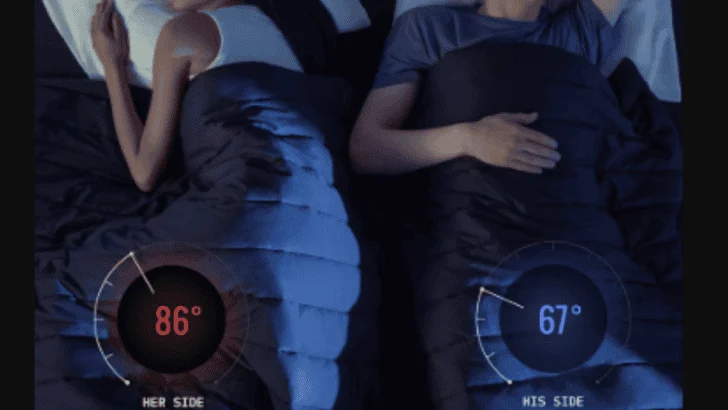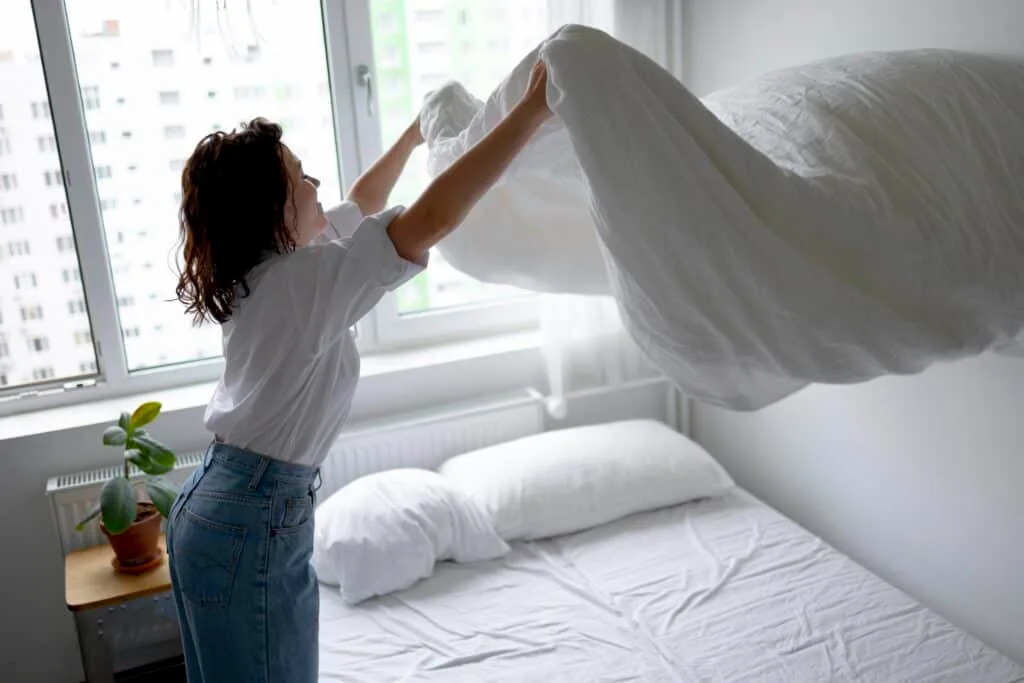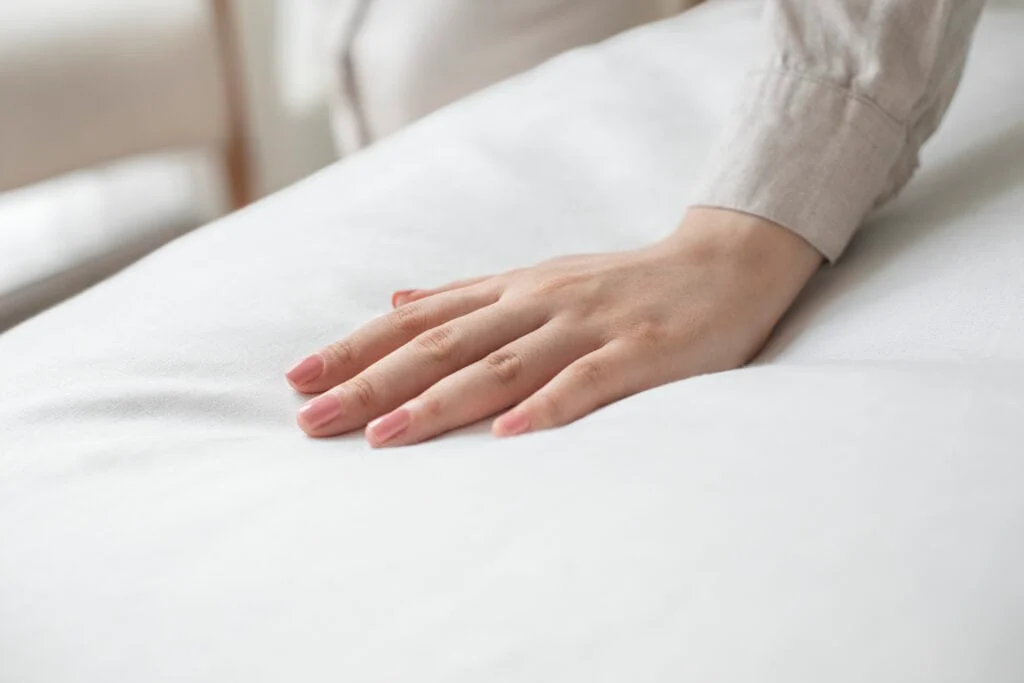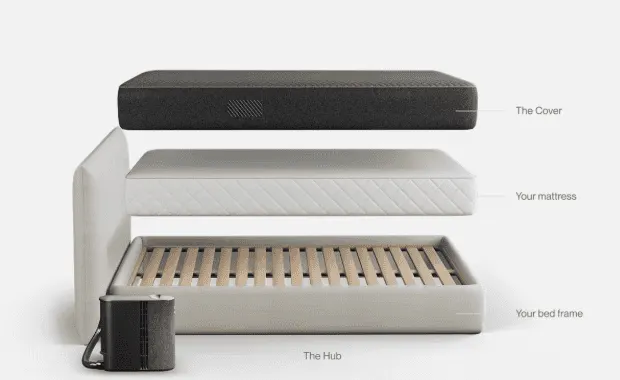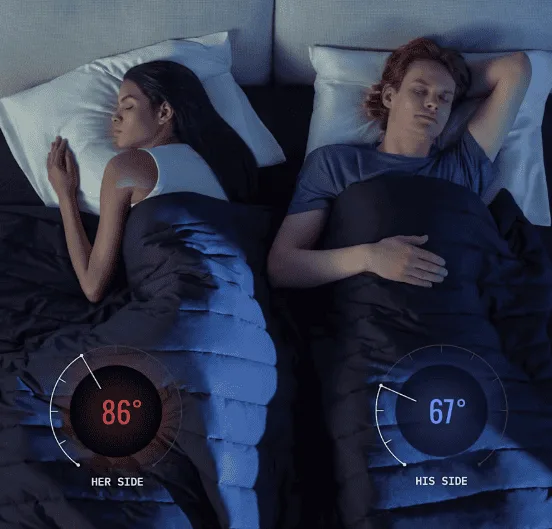- Eight Sleep vs Sleep Number Compared - November 17, 2025
- My 8 Picks for the Best Temperature-Regulating Blankets - November 16, 2025
- Best Sleep Gadgets for Hot Sleepers - November 14, 2025
If you’ve ever tried to fall asleep on a sweltering summer night without air conditioning, you know exactly how much temperature can wreck your rest. You toss, you turn, you kick off the blankets only to pull them back on a few minutes later. And when morning finally comes? You wake up groggy, sticky, and already behind on your day.
On the flip side, think about the last time you crawled under a comforter in a chilly bedroom – the air crisp, the sheets cool, and your body sinking instantly into that ahhhhh moment. Chances are, you slept not just longer, but better.
That’s not an accident. Temperature is one of the most underrated but powerful factors in sleep quality. While people obsess over the right mattress firmness or pillow loft, the thermostat in your bedroom might be sabotaging you without you even realizing it.
So, what is the best temperature for sleeping? Why does your body respond so strongly to heat and cold at night? And, most importantly, how can you set up your room so you can actually get restorative, consistent sleep – without freezing out your partner or spending a fortune on utilities?
The Science of Sleep Temperature
When you drift toward sleep, your body begins a process called thermoregulation. During the day, your core temperature averages around 98.6 degrees Fahrenheit. But in the evening, as melatonin rises and your circadian rhythm cues bedtime, your core body temperature naturally drops about one to two degrees.
That drop is what tells your brain time to rest. If your environment fights against that drop – say, your room is too warm or your bedding traps heat – your body struggles to transition fully into deep sleep.
Research consistently shows the ideal room temperature while sleeping for most adults is between 60 to 67 degrees Fahrenheit. That range supports your body’s naturally cooling process, helps you fall asleep faster, and increases time spent in restorative stages like slow-wave and REM sleep.
Signs Your Sleep Temperature Is Off
The obvious red flags are waking up sweaty or shivering. But there are subtler signs, too. When your room temperature doesn’t match your body’s naturally cooling cycle, your sleep becomes more restless and fragmented, with less time spent in deep and REM stages. You may also notice vivid or disruptive dreams from waking during REM, or a lingering grogginess in the morning despite a full night in bed.
Why Cooler Sleep Feels Better
The magic of a cool bedroom isn’t just comfort. It’s biology. When your body temperature drops, your metabolism slows down, saving energy for things like immune defense, tissue repair, and memory consolidation. Cooler conditions also trigger stronger melatonin production, the hormone that signals your body it’s time to rest.
There’s also a nervous system benefit. In a cooler environment, your heart rate and breathing naturally slow, easing you into a state of relaxation. On the flip side, being overheated causes sweating, dehydration, and small wakeups that chip away at your sleep quality, even if you don’t remember them in the morning.
In short, cooler rooms make it easier for your body to actually do the work of sleep.
How Temperature Interacts with Sleep Stages
Sleep isn’t one flat state – it’s a cycle. You move through light sleep, deep slow-wave sleep, and REM sleep multiple times per night. Temperature plays a different role in each stage.
During light sleep, your body is most sensitive to the environment. A room that’s too warm may keep you hovering in these shallow stages without ever dropping into deeper rest. Deep sleep is when most of your physical repair happens – tissue growth, immune system strengthening, and hormone regulation. Cooler conditions support longer stretches in this stage. REM sleep is the most fragile. Because your body’s ability to regulate temperature is limited during REM, an overheated room often forces you awake, cutting short the dream cycles that restore your brain.
Why It’s Not Always Simple
Of course, knowing the science doesn’t mean your room magically hits 65 degrees every night. Real life throws in plenty of complications.
You may be like me and basically turn into a furnace at night, pumping off heat like a broken radiator while my poor husband has to try and stay cool in my orbit. When one person runs hot and the other is always cold, the “perfect” bedroom temperature suddenly becomes a nightly negotiation, complete with blanket tug-of-war.
Climate adds another wrinkle. In humid southern summers, keeping a thermostat at 65 degrees might require an electricity bill you don’t want to see. In northern winters, you might deal with drafty apartments where temperatures dip below comfort.
Even your mattress can work against you. Foam models, while popular, trap heat around your body. Hybrids and innersprings tend to allow more airflow. And if you’re dealing with hormonal changes like menopause or thyroid conditions, your body may struggle to regulate temperature consistently, making sleep feel unpredictable.
How to Create the Right Sleep Environment
So how do you work with – not against – your body’s natural cooling process? Luckily, there are solutions for almost every budget and lifestyle.
1. Cooling Sheets and Bedding
The simplest upgrade starts with your sheets. If you’ve been sleeping on inexpensive microfiber or polyester blends, you’re essentially wrapping yourself in a heat trap. Switching to cotton percale can feel like night and day. Percale has a crisp, breathable weave that stays cool against the skin. Eucalyptus lyocell sheets are another great option – they feel silky, wick away moisture, and naturally regulate temperature.
Blankets and comforters matter just as much. A heavy down duvet might feel cozy in January, but suffocating in July. Instead of relying on one bulky blanket, try layering a lightweight quilt with a breathable throw. This way, you can adjust throughout the night without fully waking up.
2. Air Circulation
Never underestimate a fan. A ceiling fan can keep air moving gently around the room, reducing hot spots. A tower or box fan near the bed not only helps with airflow but also doubles as white noise, masking outside sounds. Positioning fans strategically – for instance, near a cracked window to create cross-breeze – can transform a stagnant bedroom.
3. Mattress and Topper Choices
Your bed itself can either support or sabotage cool sleep. Memory foam mattresses are notorious for trapping heat, while hybrids with coil layers promote more airflow. If replacing a mattress isn’t in the cards, a cooling topper can help. Latex toppers are naturally breathable, while some memory foam models come with gel infusions or covers designed to draw heat away from your body.
4. Smarter Room Climate
Sometimes it’s not the bed – it’s the room. Blackout curtains can block sunlight during the day and prevent heat buildup. In humid areas, a dehumidifier can make a room feel cooler even if the thermostat hasn’t changed. Smart thermostats let you program temperature drops and night and gradual warming toward morning, so your sleep cycle stays in sync without manual adjustments.
5. Active Cooling Systems
If you’ve tried all the basics and still struggle, it may be time to consider sleep tech. Active cooling systems regulate your bed’s temperature independently of the room, giving you precision control.
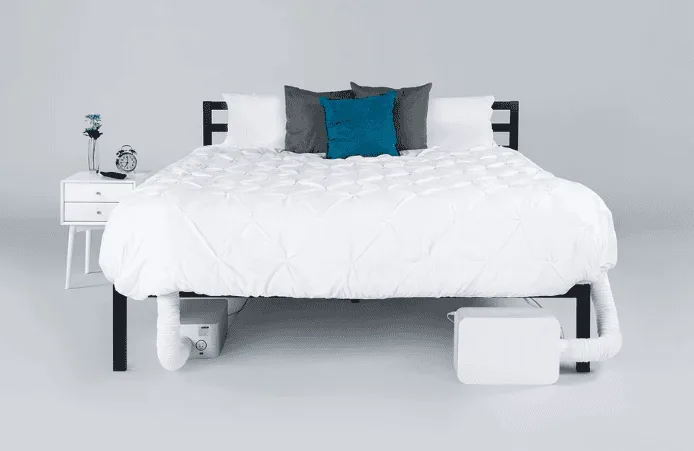

The BedJet, for example, blows cooled or heated air directly under your covers, perfect if you like the feel of airflow. The Chilipad Dock Pro uses circulating water to maintain a static temperature across your mattress pad.
Then there’s the Eight Sleep Pod, which takes things a step further. Instead of holding one temperature, it monitors your sleep throughout the night and adjusts automatically. If you tend to overheat in the early morning hours, the Pod cools you down. If you wake up chilly before dawn, it warms you up again. Each side of the bed can be programmed separately, and it even integrates sleep tracking so you can see how your rest improves over time.
These systems range in price, but for people who chronically overheat or who share a bed with someone whose preferences are the opposite, the investment can be life-changing.
What If You Run Cold?
Most advice focuses on hot sleepers, but cold sleepers exist, too. If you find yourself waking up shivering, the fixes are simple. Cotton sateen or flannel sheets provide warmth without suffocating weight. Adjust your thermostat closer to 67 degrees instead of dipping to the low 60s. Active cooling systems also have heating modes; the Eight Sleep can pre-warm your side of the bed before you even climb in.
The goal is always balance – you want your body relaxed, not bracing itself against the environment.
Finding Your Sweet Spot
Here’s the truth: while science gives us a recommended range, there’s no universal number. Some people thrive at 62 degrees, while others feel their best at 66 degrees. The key is consistency and experimentation.
Try setting your thermostat at 65 degrees for a week before you go to bed. Pay attention to how quickly you fall asleep, whether you wake during the night, and how you feel in the morning. Then adjust by a degree or two in either direction. Layer in other tools gradually – a fan, a different sheet set, or a cooling topper – so you can pinpoint what actually makes the difference.
If you’re data-driven, a sleep tracker can be helpful. Even journaling how you feel each morning can reveal patterns you might not otherwise notice. One large study on older adults showed sleep efficiency dropped significantly when nighttime bedroom temps rose above 77 degrees. It’s proof that the margins really do matter.
Why It Matters
Getting sleep temperature right isn’t just about being comfortable. Sleep is when your body restores itself, and when temperature disrupts those cycles, the consequences ripple outward. Cognitive function, mood regulation, metabolism, and immune defenses all take a hit. Even small disruptions, repeatedly nightly, add up.
Final Thoughts
If there’s one golden rule for sleep, it’s this: cooler is better. Somewhere in that 60 – 67 degree range lies your personal sweet spot.
If you need to cool down, start with the basics – breathable sheets, layered bedding, a simple fan. If you need more, explore cooling mattresses, toppers, or smart thermostats. And if you want the ultimate set-and-forget it approach, active cooling systems can fine-tune things while you focus on actually sleeping.
The perfect temperature isn’t just about the number on your thermostat. It’s about giving your body the environment it needs to recover, recharge, and truly rest. Once you lock in that balance – cool enough to relax, warm enough to feel secure – you’ll wonder how you ever slept any other way.

